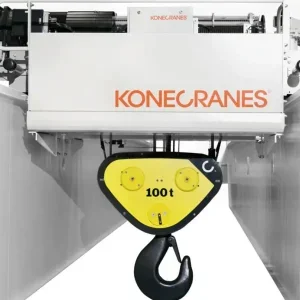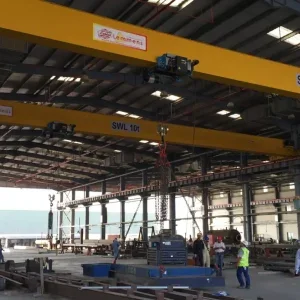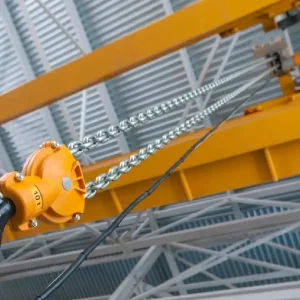At under $3,000 (Euro 2,460) for a complete floor-supported crane, the SnapTrac enclosed-track monorail crane kit is certainly one of the cheapest cranes ever sold.
A 12ft (3.6m) by 12ft gantry crane kit complete with floor-standing pillars costs just $2,046, or $600 more with powered long and cross travel. A simple 12ft hanging monorail costs $349 without power, though additional sections can be bought to extend the running length of the system. Hoists are sold separately.
The crane has a 12ft (3.6m) bridge and can lift 1,000 lbs (900kg).
The components are mass-produced by Kundel in Ohio, USA, and packed into boxes in the factory. “That’s the only way to reduce cost in the system,” said Bob Kundel, Jr, crane division director.
“We have made a crane that an everyday guy can afford to put in his garage,” he said. The cranes are marketed more toward tooled-up home users than the lifting industry proper.
Kundel also makes enclosed track systems sold by Konecranes to the industrial market in the USA. “The industrial line is three to four times that price, because of the reduced labour. The customer takes the components and bolts them together.”
Kundel did not seem concerned about the risks of a crane being put up by unskilled workers. “Our instruction manual is very well detailed, telling them how to fasten the components together, with what torque requirements and with thread locking solution,” Kundel Jr said. “If you follow the manufacturers’ specification, there should be no problems.”
He added that in case of an overload, the crane has been designed to jam rather than drop a load. The company proof-tested the crane to 10,000 lbs (4500 kg) before a trolley wheel cracked. It rates the crane at a CMAA duty class of “C/D,” moderate to heavy use.
The company has sold about 100 cranes. Konecranes Inc is selling them through its Crane Pro Services distributor network, and Kundel also has some catalogue shops signed up. The crane is not currently CE-marked.
Half of the orders so far have been from industrial users, he said. “We are getting a lot of orders for auto restoration,” he said.
The posts need to sit on 4in (100mm) of concrete. They come in heights of 10ft, 12, 14 and 16ft. The crane itself has two feet of headroom down to the bridge eye; users would then need to subtract the headroom of the hoist.
The conductor rail is supplied by Vahle. The rail units come as a separate kit and slide into the enclosed rail profile.
There is an even cheaper option. Do-it-yourself kits have been around for years. Eldon Goates says he has sold 200-300 copies of his designs for a two-legged crane gantry. Although the plans have a bill of materials, steel cutting and welding is required. Boasting a capacity of up to 6,000 lb (2.7t), depending on materials and construction techniques, the crane gantry design is only $13.99 on the Synthesis Engineering Services web site (www.synthx.com/btw/crane.htm). The main cost will be the raw steel. Each of the legs weigh about 70 lbs and the main 5-inch girder is 100 lbs, Goates said.






